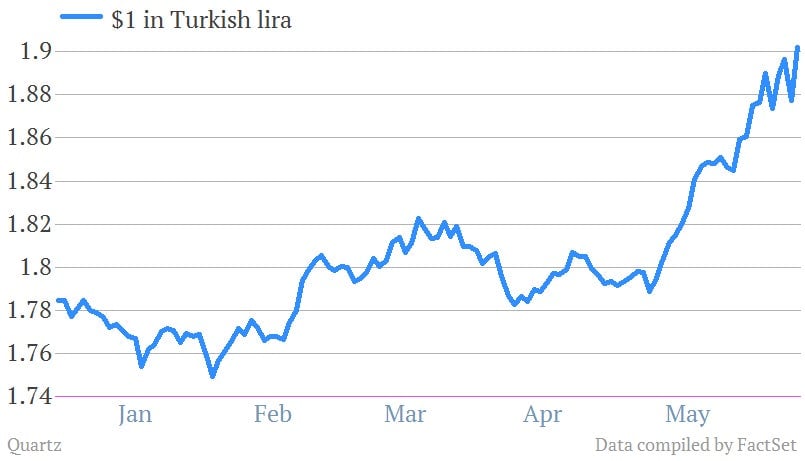The indicator every Turk is watching to see if the protests are hurting the economy
Renewed violence in Istanbul’s Taksim Square today has reignited concern that the situation in Turkey could cause the country lasting economic damage. And for the average Turk, there’s one indicator that symbolizes the strength of the economy and could call into question popular support for prime minister Recep Tayyip Erdogan: the exchange rate between the Turkish lira and the US dollar.



Renewed violence in Istanbul’s Taksim Square today has reignited concern that the situation in Turkey could cause the country lasting economic damage. And for the average Turk, there’s one indicator that symbolizes the strength of the economy and could call into question popular support for prime minister Recep Tayyip Erdogan: the exchange rate between the Turkish lira and the US dollar.
“This is something the Turkish people really care about,” Eurasia Group analyst Naz Masraff explained in a conference call yesterday. She predicted that even members of Erdogan’s own party would begin to care about a weakening lira, particularly around the psychologically important 2 TL per dollar mark.
Wolfango Piccoli, Managing Director for Teneo Intelligence, doubted that this is an exact science, however. ”What exactly the threshold is for the public to determine things are going badly is a question mark,” he told Quartz in a phone call.
But he agreed that the lira will influence public support for Erdogan’s unwillingness to bend to protesters’ demands. “The exchange rate between the Turkish lira and the dollar is a very powerful indicator for the Turks,” he says. ”It’s a heritage of the past, [of] when the Turkish economy was going through lots of turbulence in 2001 and 2002.”
Inflation hit 39% in 2000. In early 2001, an attempt to peg the currency to a basket of currencies, including the dollar and the euro, failed. The lira fell by one third overnight (pdf). “When you left the house in the morning, you didn’t know what your purchasing power was,” says Piccolo. An IMF bailout and financial-sector reforms eventually stabilized the economy, but an obsession with the lira-dollar exchange rate continues to this day. ”When you go to Turkey, the man on the street will know what the exchange rate is.”
The lira has weakened sharply against the dollar since May 8, well before the protests in Taksim Square drew international attention. In today’s trading, the rate stood steady around 1.89 lira to US dollar.